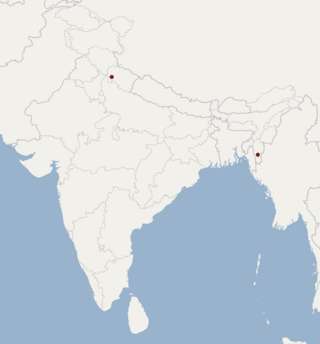
Elasmucha grisea, common name parent bug, is a species of shield bugs or stink bugs belonging to the family Acanthosomatidae. The term parent bugs includes also the other species of the genus Elasmucha and some species of the family Acanthosomatidae.

Magnaporthe grisea, also known as rice blast fungus, rice rotten neck, rice seedling blight, blast of rice, oval leaf spot of graminea, pitting disease, ryegrass blast, Johnson spot, neck blast, wheat blast and Imochi (稲熱), is a plant-pathogenic fungus and model organism that causes a serious disease affecting rice. It is now known that M. grisea consists of a cryptic species complex containing at least two biological species that have clear genetic differences and do not interbreed. Complex members isolated from Digitaria have been more narrowly defined as M. grisea. The remaining members of the complex isolated from rice and a variety of other hosts have been renamed Magnaporthe oryzae, within the same M. grisea complex. Confusion on which of these two names to use for the rice blast pathogen remains, as both are now used by different authors.
Prunus grisea is a species of plant in the family Rosaceae. It is found in Malaysia, the Philippines, Singapore, and Taiwan.

Peters's tube-nosed bat is a species of vesper bat in the family Vespertilionidae, found in the Indian Subcontinent, mainly in the Western Himalayas. They have tube-shaped nostrils which assist them with their feeding. They are brown with white-yellow and underparts and have specks of orange around their neck. While they are roosting, their fur, which seems to appear as a dead plant, camouflages them from predators. They are 3.3-6.0 cm in length and have round heads, large eyes and soft fur. This bat is found in India. They are endangered due to clearing of the rain forests in which they live in and are not protected by the World Conservation Union. They feed on rain forest fruit and blossoms.

Nicholas José Talbot FRS FRSB is Group Leader and Executive Director at The Sainsbury Laboratory in Norwich.
Diadelia is a genus of longhorn beetles of the subfamily Lamiinae, containing the following species:
Diadelia albovittata is a species of beetle in the family Cerambycidae. It was described by Breuning in 1957.
Diadelia flavicollis is a species of beetle in the family Cerambycidae. It was described by Breuning in 1957.
Diadelia flavovittipennis is a species of beetle in the family Cerambycidae. It was described by Breuning in 1957.
Diadelia granulipennis is a species of beetle in the family Cerambycidae. It was described by Breuning in 1957.
Diadelia griseata is a species of beetle in the family Cerambycidae. It was described by Breuning in 1957.
Diadelia imitatrix is a species of beetle in the family Cerambycidae. It was described by Breuning in 1939.
Diadelia affinis is a species of beetle in the family Cerambycidae. It was described by Breuning in 1939.
Diadelia lignea is a species of beetle in the family Cerambycidae. It was described by Breuning in 1940.
Diadelia lineata is a species of beetle in the family Cerambycidae. It was described by Breuning in 1943.
Diadelia ochreovittata is a species of beetle in the family Cerambycidae. It was described by Breuning in 1970.
Diadelia nitidipennis is a species of beetle in the family Cerambycidae. It was described by Breuning in 1966.
Diadelia densemarmorata is a species of beetle in the family Cerambycidae. It was described by Breuning in 1964.
Diadelia laeviceps is a species of beetle in the family Cerambycidae. It was described by Breuning in 1942.
Diadelia nervosa is a species of beetle in the family Cerambycidae. It was described by Fairmaire in 1871.



